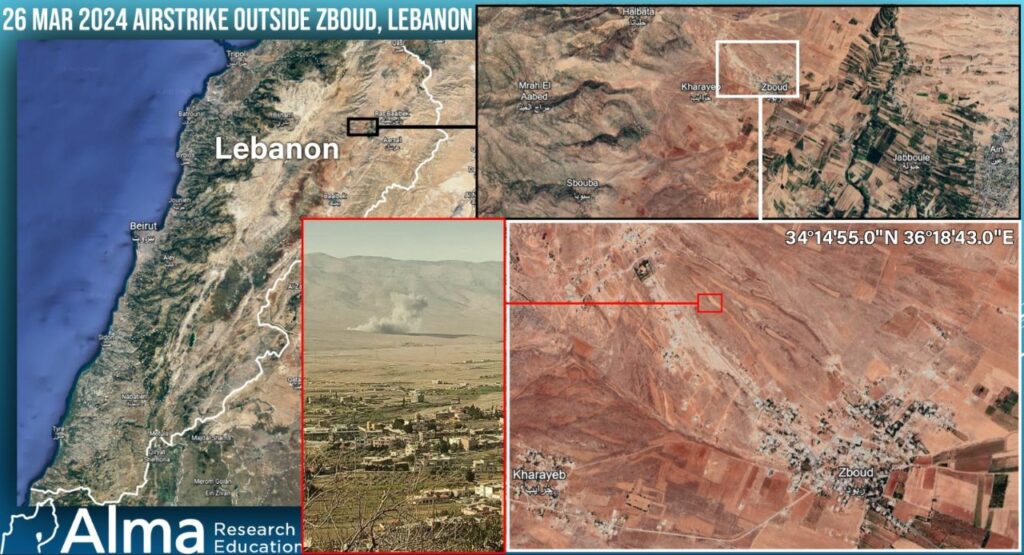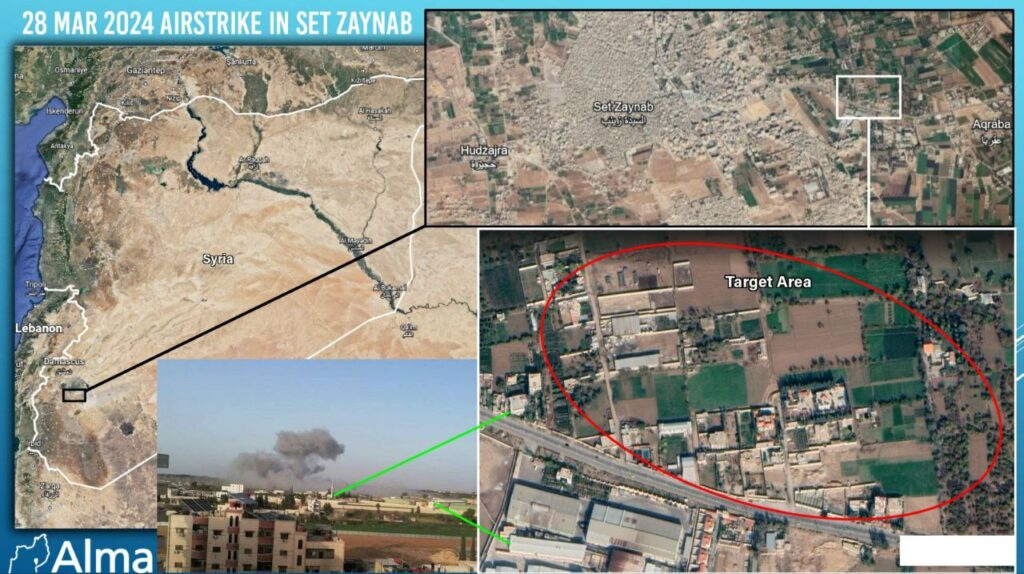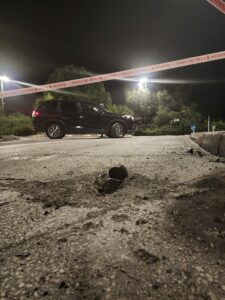Key insights:
- The activity of the Iranian arms corridor and its infrastructure in Syria appears to have increased significantly. As previously reported, Iran intends to construct a weapons production and development infrastructure on Syrian land based on Iranian know-how, utilizing the existing platform of the CERS locations. This week, attacks were launched on the CERS Suleiman (March 29) and Jamraya-Dumar (March 31) facilities.
- The IDF is seeking to target Hezbollah’s senior professional knowledge centers: On March 29, a senior operative in Hezbollah’s rocket fire system in the south was eliminated, while on March 31, a key operative in Radwan’s anti-tank team was killed in Kunin.
Monthly Summary

This month, the average number of claims of responsibility was around nine per day. Hezbollah’s main armament was rocket fire, combined with anti-tank missiles, UAVs, and anti-aircraft weapons. This month, Hezbollah’s anti-tank missile fire has significantly decreased. In February, there were 75 incidences of anti-tank missile fire, compared to only 48 in March.
In addition, Hezbollah’s use of UAVs significantly increased this month, with 31 occurrences (some of which had no claim of responsibility) compared to 7 the previous month. This month, Hezbollah launched four major UAV attacks, as he claimed: on the Iron Dome battery and military bases.
The Lebanese arena:
War data:

In Israel, the government evacuated 43 communities located up to five kilometers from the Lebanese border. A total of about 61,000 citizens. To them were added several thousand more who decided to evacuate independently.
It should be noted that not all Israeli communities have been totally evacuated, and there is still a civilian presence. This is because these communities rely on tourism and agriculture. Farmers come to work on the land, in the orchards, tending to cow and goat herds. Furthermore, some of the communities’ industrial plants are still operational and employ workers from non-evacuated areas. In addition, some of the evacuees returned independently.
The Israeli government has extended the evacuation period until the summer of 2024 (July/August 2024).
Hezbollah has killed 6 Israeli civilians and 1 agricultural worker with foreign citizenship so far. A total of 7 civilians were killed.
During the past week, Hezbollah claimed responsibility for 61 rocket launches and rockets fired at Israel (including Burkan, Falaq-1, and Grad), anti-tank missiles, and UAVs.
No one claimed responsibility for eleven other occurrences, most of them UAV infiltrations into Israeli territory and one incident of rocket fire.
This week, the average number of responsibilities claimed was approximately 10 per day. Furthermore, about 50% of the targets this week were or might have been civilian. Potential civilian targets are occurrences in which high-velocity fire is directed against areas designated by Hezbollah as military targets. However, these are high-trajectory targets with a significant risk of causing harm to civilian communities.
Prominent launching and shooting incidents against Israel:
(March 26) Anti-tank missiles fired at Meron Air Force Base.
(March 26) Approximately 50 rockets fired at the Golan Heights.
(March 26) Hezbollah focused on civilian targets and fired rockets and anti-tank missiles at the communities of (claiming responsibility): Shomera, Shlomi, Avivim, Shtula and Hanita.
(March 27) Dozens of rockets were fired at Kiryat Shmona, one direct hit on a factory, killing an Israeli civilian and wounding six others.
(March 28) Hezbollah launched Grad and Burkan rockets toward the communities of Goren and Shlomi. This is the first time Hezbollah has fired Burkan-type missiles toward civilian targets, declaring them as the intended targets. Since the start of the war, Hezbollah has fired Burkan rockets against military objectives, with some landing in civilian areas.
According to the Israeli Taxes Authority since the beginning of the war, 2,062 claims for property damage have been received in the Haifa district and the north, of which 1,137 buildings are in the north.
On 29.03, Defense Minister Yoav Galant announced that the IDF would increase the pace and expand the campaign. Galant said the IDF would reach wherever Hezbollah was, in Beirut, Damascus, and further. He also stated that Hezbollah was responsible for the severe damage in Lebanon.
Hezbollah casualties:
Over the past week, statements were released reporting 18 Hezbollah military operatives killed, including the deputy of the rocket fire system in southern Lebanon and several Hezbollah operatives killed in an airstrike near the city of Aleppo in Syria.
In addition, seven operatives of Al-Fajr, the military wing of the Al-Jama’ah al-Islamiyah (Muslim Brotherhood), and one operative from the Amal movement were killed.
As of October 8, 2023, a total of 264 Hezbollah operatives have been killed. Most of the operatives killed live south of the Litani River (176 operatives killed, constituting 66% percent of all the operatives killed). Many Hezbollah operatives and their families live in southern Lebanon near the border with Israel. They operate in southern Lebanon as part of Hezbollah’s geographic units (Nasser/Aziz) and Hezbollah’s designated units (Radwan unit), while assimilating into the civilian population (human shield tactics).

Prominent airstrikes in Lebanon:
(March 26) In response to the attack on the Meron Israeli airbase on March 26, the IDF attacked a Hezbollah aerial unit compound in the northern Bekaa Valley, which contains buildings (apparently including a command-and-control building) and a UAV landing strip. The compound is located between the towns of Zboud and Wadi Fara.

(Mar. 26) On the same day, a second strike was launched against a Hezbollah air unit compound in the Bekaa Valley. This attack struck west of Baalbek, near Budai. It is worth noting that Hezbollah’s additional strategic systems are also stationed in the Bekaa Valley, including its long-range ballistic missile system, development, weapons production and storage, air defense, and Hezbollah training facilities.

(March 27) The IDF attacked a building in the Sunni village of Al-Habariya, located on the western slopes of Har Dov, south of Hasbaya. The attack was directed against a squad of operatives belonging to the Al-Fajr Forces, the military wing of the Al-Jama’ah al-Islamiyah movement in Lebanon, who were preparing to carry out imminent terrorist attacks against Israel, apparently in the form of a foot infiltration into Israeli territory in the Har Dov area.


(March 29) An airstrike on a vehicle in the village of Al-Bazouriye, east of the city of Tyre. Senior Hezbollah operative, Ali Na’im Muhsali al- Bazouriye, also known as Abu Mahdi the African (“Al-Afriqi”), from the village of Sela, was eliminated. He served as deputy head of Hezbollah’s rocket fire system in southern Lebanon.


(March 31) An attack on a vehicle in the village of Kunin where Ismail Ali al-Zein, a key operative in Hezbollah’s Radwan force’s anti-tank unit. Ismail Ali al-Zein served as Radwan commander and was a central body of knowledge in the field of anti-tank missiles, also responsible for dozens of anti-tank attacks aimed at IDF forces and the Israeli home front.

Hezbollah – General:
Nasrallah’s speech (March 29):
Nasrallah spoke on the first night of Laila al-Qadr, marking the beginning of the last ten days of Ramadan. In his speech, Nasrallah called for broad participation in marking International Jerusalem Day on Friday, April 5. This is the annual day marked in Iran on the last Friday of Ramadan and is intended to express general opposition to Zionism, and in particular to the State of Israel’s control of Jerusalem. The day’s events include demonstrations and street rallies in Iran and other countries along the resistance axis. Outside the Middle East and Arab countries, Quds Day protests were held several times in Britain, Germany, Austria, France, the United States, and others. Nasrallah stressed that “Al-Quds Day comes this year under completely different and escalating circumstances,” and called for the widest possible participation to mark International Quds Day “in all places, especially in the southern suburbs, where the main celebration will take place to confirm the marking of the event.”
(March 26) Palm Sunday celebrations in the Christian hamlet of Ramish in southern Lebanon sparked heated debate on social media. Many Lebanese, both Christian and Shi’ite, debated on social media whether to hold the march considering the war’s developments.
The hostility and enmity between Ramish’s Christian population and Hezbollah have existed for a long time. Hezbollah is continually attempting to tighten its military grasp on the village but faces opposition from local citizens. See our article on the subject.

(March 30) UNIFIL troops were attacked in the Ramish district of southern Lebanon. According to local sources, a missile was launched at the force, injuring four men. Initially, pro-Hezbollah groups attempted to blame Israel for the strike. However, the main hypothesis in Lebanon is that the UNIFIL unit approached an area where Hezbollah operatives had positioned rocket launchers aimed at Israel and was thus assaulted by Hezbollah. This is another episode in which Hezbollah attempts to develop military activities near the settlement of Ramish.
Lebanon – General:
(March 29) Italian Prime Minister Giorgia Meloni visits Lebanon to help Lebanon overcome the political and economic crisis the country has experienced since 2019.


The Syrian arena:
Prominent airstrikes in Syria:
(March 26) An airstrike was carried out in eastern Syria, in the geographic strip between the city of Albukamal and the city of Deir a-Azur, striking approximately 10 targets. There are conflicting reports regarding the fate of Haj Askar, the IRGC’s military commander in charge of the Shiite militias in the region. See our article on the topic: An Israeli message to the Iranians.

(March 28) Several targets were attacked around Sayyida Zaynab, south of the capital Damascus, which is known to be considered a Shiite area used as a residence and activity for senior Iranian and Hezbollah operatives in Syria, which has been attacked several times. According to local reports, a building used by Hezbollah and IRGC was attacked, resulting in two injuries but no fatalities reported.


(March 29) According to local Syrian accounts, locations in the Aleppo area were hit early on March 29. It is suspected that a scientific research complex known as “Suleiman” belonging to the CERS institution, located around 25 kilometers southeast of Aleppo, was targeted. The assaulted compound is approximately 5 kilometers south of the main compound of the security factory near Al-Safirah, which also houses CERS sites (which were targeted in May 2023). They also reportedly struck targets in the village of Joum, west of Aleppo, and the Jabarin neighborhood near Aleppo Airport. There were numerous casualties, including Hezbollah operatives. According to our evaluation, the CERS complex that was targeted is linked to Institute 4000, which is involved in the precision missile and rocket project.

(March 31) The Jamraya-Dumar site may have been attacked, northwest of Damascus and near Mount Qasioun. Weapons intended for transfer to Hezbollah are kept there. In addition, there are several significant CERS Center institutions and divisions. Institute 1000 and Institute 2000. The 2000 Institute is in charge of the research, development, and mechanical manufacture of Syria’s armaments project, which includes missiles and mortars. The Electronic Institute (Institute 1000) is in charge of producing and developing various computer and electronic systems, such as navigation systems, observation instrumentation, and radar.

Since the beginning of the war, there appears to be a significant acceleration in the activity of the Iranian arms corridor and its infrastructure in Syria (including CERS facilities). As we have reported in the past, the Iranian trend is to establish a weapons production and development infrastructure on Syrian soil based on Iranian know-how, using the existing platform of CERS sites. See the report of The Weapons Development Industry in Syria (CERS).
Shiite Axis – General:
(March 25) It was revealed that the ISA and the IDF had foiled the smuggling of advanced Iranian weapons from Jordan, which were intended for terrorist operatives operating in Judea and Samaria. The smuggling was managed by IRGC Intelligence Directorate 4000. In our assessment, the narcotics smuggling platform from Syria to Jordan is used by the Iranians and Hezbollah to smuggle weapons. The weapons are intended mainly for Hamas, Islamic Jihad, the Al-Aqsa Brigades (Fatah) and operatives from the Abu Ali Mustafa Brigades (the PFLP’s military-terrorist wing) in Judea and Samaria. See our article on the subject.

Since October 2023, there have been more than 160 shooting incidents at U.S. bases in Iraq and Syria, mostly in eastern Syria.
During the past week, the Shiite militias in Iraq claimed responsibility for five incidents of launching UAVs toward Israel:
)March 26) An attack on the Ovda air base.
(March 27) An attack on Sapir base.
(March 29) An attack on a base in the Golan Heights.
(March 31) An attack on a “vital target” in Eilabun in the Galilee.
(April 1) An attack on an important target in Eilat. According to the IDF Spokesperson’s announcement: Following warnings concerning the infiltration of hostile aircraft in Eilat and the Eilot region, IDF forces identified a suspicious aerial target that crossed from the east towards Israeli territory, the suspicions aerial target fell in the Gulf of Eilat area, there were no casualties and minor damage was caused to a structure.
The most recent attack on American bases in Iraq and Syria took place on February 20. According to various reports, the attacks on the American bases ceased due to direct Iranian instructions to the Shiite militias, against the background of secret agreements between Iran and the United States. It should be noted that at this stage it is unclear whether a decision has been made by the Shiite axis to renew the attacks. According to local reports in Syria, on March 24 and March 26, rocket and UAV attacks were carried out against two American bases in eastern Syria. There are currently no further indications to corroborate these reports.

Yemen – Houthi-land:
Over the past week, coalition forces managed to strike 6 UAVs launched or intended for launch by the Houthis.
Since October 2023, there have been 96 Houthi shooting incidents against Israeli ships and targets.






